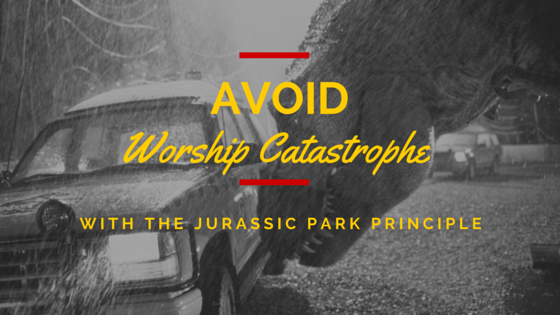As a geeky kid growing up in the early 90’s, nothing hit my radar quite like Jurassic Park. (well…maybe Wayne’s World). I remember when the cool guy who helped me earn my Science merit page in Boy Scouts took me to the opening night of the movie. I had already read my paper back copy of the book several times and was excited about seeing the story brought to the big screen. Jurassic Park was a movie that EVERYONE saw.
I think there is an important lesson church leaders can learn from Jurassic Park when planning worship. I would even go so far as to say it is a timeless message. It is a lesson both worship leaders and scientists creating large and destructive living beings from fossilized DNA should understand. I call it the Jurassic Park principle.
JUST BECAUSE YOU CAN DOESN’T MEAN YOU SHOULD.
You never know when things might get out of control.
Maybe your lighting crew can make a holographic depiction of the Death Star and your Youth Pastor can make it into an illustration on the one Sunday they teach at traditional worship…but should you really?
Maybe you really are getting into ancient liturgy and your community has gotten down reciting the Apostles Creed, but jumping straight into the Rite of Constantinople might go over their heads.
You have a great preaching illustration taken from The Age of Ultron, but the last movie most of your congregation saw in the theater was Driving Mrs. Daisy, will it truly work?
For younger ministers, there is a huge temptation to delve off into unknown creative waters when leading our congregations in worship. We might have seen something cool at a conference or around the internet and think it will be the thing that catapults our worship into truly skinny jean worship leader status…but are we willing to experiment at the expense of those we worship with? How far does that truly lead our churches into a deeper and more incarnational aspect of faith?
What might seem really cool to us and a few others could be the theological equivilent of unleashing a pack of velociraptors in the sanctuary. Remember the most important word in Worship Design is context. Sometimes innovative things will match our ministries well. Other times we need to step back and realize something might not be best for our church. This is all part of the process of discernment. Our job as leaders, whether music, logistics or preaching is to present Christ to people and facilitate the worship of the Triune God in the most approachable and accessible way for the people we worship with.
Just because we can doesn’t mean we should.



 Chad Brooks is a United Methodist Pastor serving in Louisiana. Married to Meredith, he is currently starting a new church in northeast Louisiana. Host of the Productive Pastor Podcast and lover of motorcycles, Chad would love to find Bigfoot one day.
Chad Brooks is a United Methodist Pastor serving in Louisiana. Married to Meredith, he is currently starting a new church in northeast Louisiana. Host of the Productive Pastor Podcast and lover of motorcycles, Chad would love to find Bigfoot one day.
Thanks for the good humor Chad!